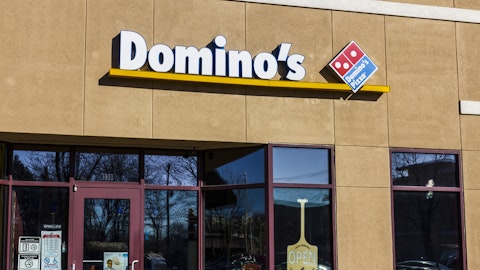Operator: And one moment for our next question. And our next question will come from Joshua Long of Stephens. Your line is open.
Joshua Long: Following up on that, when we think about some of these opportunities, Rob, and then also the improvement to date, seems like there’s a lot of runway in terms of thinking about those three initiatives you outlined in terms of particularly the revenue management and the comments you just shared. When you think about that improvement to date, how much of that is being driven by some of these focus points that you’ve outlined? And then just, I mean, as we look back in the model, comparisons Diddy or Dewey, as we think about 3Q versus last year. So, how much of that is just maybe the environment normalizing a little bit after you move past April and/or what kind of context can you offer up in terms of just what ending or kind of the process of rolling out some of these, what seemed to be longer term meaningful initiatives in terms of the top-line profitability, execution at the store level?
Rob Lynch: What I would tell you is that our company restaurants right now are executing at an extremely high level, from an operation standpoint, from a revenue management standpoint, from an advertising and promotion standpoint. So, the way our company restaurants are performing gives me a high degree of confidence in our ability to take advantage of the runway that you highlight. The model really hasn’t changed. I mean, we’re still focused on driving innovation, both on the product side as well as the technology side, making sure that we’re unlocking the white space that we have both domestically and internationally, and making sure that we are helping, making sure that our restaurants are running and economic model that will warrant continued investment in new stores.
So, we’re seeing that in, in the Company side, probably stronger, obviously you have the pandemic period where there was some artificial inflation and demand given the situation that we were all faced with. But in regards to kind of a normalized run rate, which I do feel like we are, are kind of entering into, Q2 is probably the quarter where we kind of broke from a lot of kind of the pandemic lapping and comparables. We’re entering into a much more normalized run rate, and this is about as strong of an operating model as I’ve seen in our restaurants to date. So our goal is to make sure, as Brian highlighted, that our franchisees are set up to deliver as strongly moving forward. And all the fundamentals are there. I mean, we’re selling the same food with the same business model.
We just have to tweak some of the capabilities and how it’s being executed at scale across our franchise system. So we have the ability to do that. We’re focused on it. We know where the challenges and the gaps are and that’s what gives us so much confidence moving forward.
Operator: One moment for our next question. Our next question will come from Sara Senatore of Bank of America. Your line is open.
Sara Senatore: I was interested to hear about your comments about the aggregator mark channel and how you were early to that. I was wondering two point part question. One is, can you talk about if there are any differences in the competitive dynamics online versus offline? I think there’s a general view that’s been articulated that aggregator customers are less value seeking than perhaps people who are offline and I was curious to the extent that you talked about the importance of value, if maybe that was the wrong perception. And then related question is, with your faster out the door times now, at company stores, sounds like perhaps hiring and productivity issues are behind you. Would you contemplate bringing all the delivery piece in-house as opposed to the delivery as a service component that I think you used now?
Rob Lynch: Thanks Sara. When we talk about the competition online versus offline, I mean, everything that we do is online, essentially. 85% of our business comes across digital channels and 15% that goes into is our phone calls now go into a centralized call center and then come in digitally. So everything that we do is online. Now the difference is between our organic online and our aggregator online. And so I think that’s where you’re driving the question. And I think historically you have seen, aggregators have less price sensitivity and be less value seeking. I think as the aggregators have scaled and as the aggregators become a larger population, you’re seeing their behaviors and their affinities be more similar to kind of the macro, more to the general population.
But what I will tell you is that, we are focused and have been able to create a dichotomy where our organic channels offer our repeat customers a better value, primarily through the loyalty program that we offer and Papa Rewards program, I mean, it’s going to be really hard for someone to go onto one of the aggregators and get a better deal than we can offer them through our organic channel. So what you see is a lot of the aggregator volume is incremental because the people that are best customers are typically buying through our organic Papa John’s website or mobile apps. So, I don’t know that the consumer price sensitivity is significantly different across the channels at this point. I think it was early on as you had early adopters coming in.





